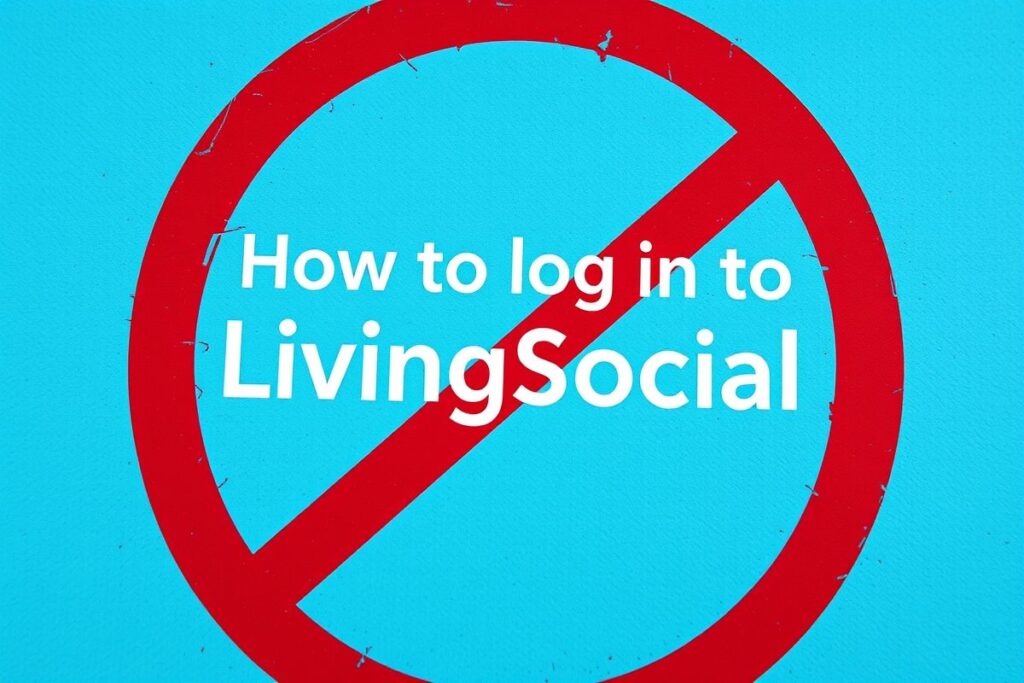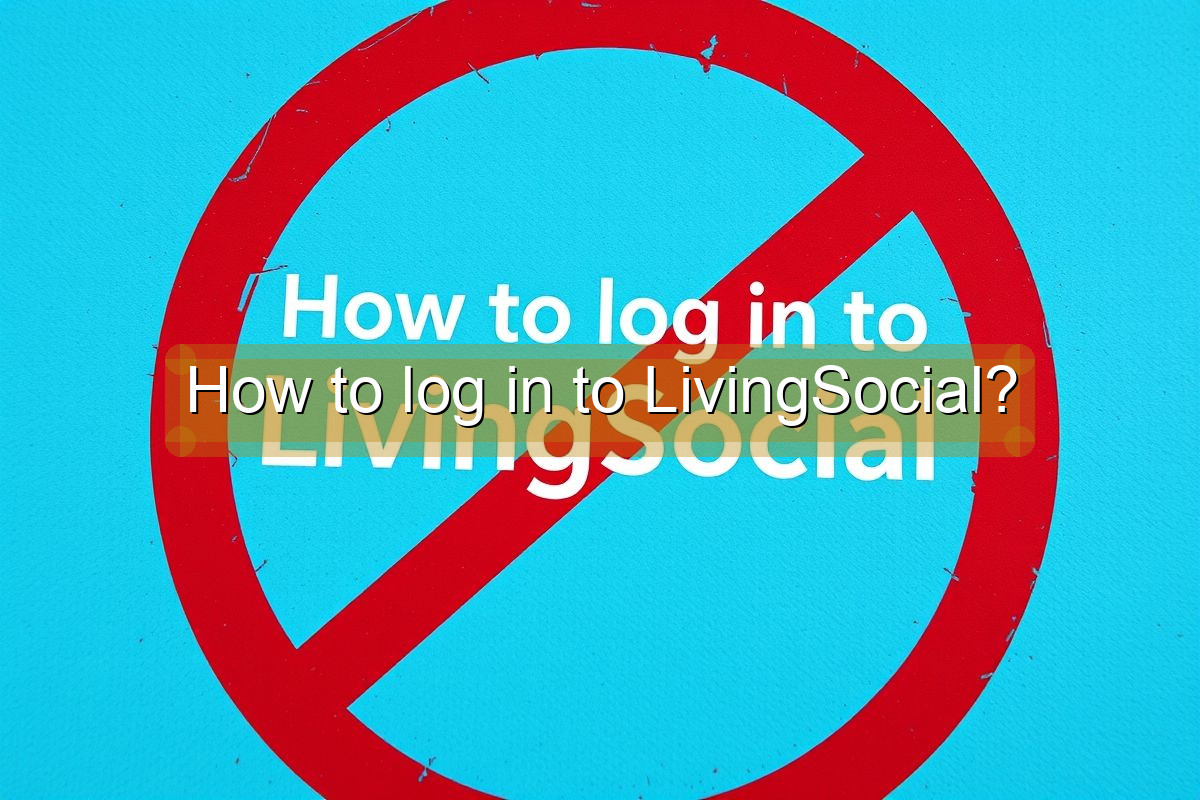“`html

Effortlessly Accessing Daily Deals: How to Log In to LivingSocial
In the realm of online deal hunting, LivingSocial stands out as a prominent platform connecting consumers with a vast array of experiences, products, and services, often at significantly discounted prices. From exciting getaways to delectable dining experiences and rejuvenating spa treatments, LivingSocial offers a diverse range of opportunities to enhance your lifestyle without breaking the bank. Navigating the platform and accessing these incredible deals begins with the simple yet crucial process of logging in. This guide will walk you through the various methods of logging in to your LivingSocial account, ensuring you can seamlessly access the latest deals and start saving on the things you love.
Whether you’re a seasoned deal seeker or new to the world of online discounts, understanding the login process is essential for maximizing your LivingSocial experience. We’ll cover everything from the standard email and password login to alternative methods like using your Facebook or Apple account. By the end of this article, you’ll be equipped with the knowledge and tools to effortlessly access your account and start exploring the exciting world of LivingSocial deals.
Logging In with Your Email and Password
The most common and straightforward method for accessing your LivingSocial account involves using your registered email address and password. This approach provides a secure and reliable way to confirm your identity and gain access to your personalized account settings, saved deals, and purchase history.
The Standard Login Process
To begin, navigate to the LivingSocial website or open the LivingSocial mobile app. Locate the “Sign In” or “Log In” button, typically found in the upper right-hand corner of the website or within the app’s menu. Clicking this button will direct you to the login page, where you’ll be prompted to enter your email address and password. Ensure that you enter the correct email address associated with your LivingSocial account. Double-check for any typos or errors, as even a small mistake can prevent you from logging in.
Next, carefully enter your password in the designated field. Passwords are case-sensitive, so be mindful of capitalization and any special characters you may have used when creating your account. If you’re unsure whether you’re typing the correct password, many websites offer a “Show Password” option, which temporarily reveals the characters you’re entering. After entering both your email address and password, click the “Sign In” or “Log In” button to proceed.
If your credentials are correct, you’ll be successfully logged in to your LivingSocial account. You’ll then be able to browse the latest deals, manage your account settings, and make purchases. However, if you encounter an error message indicating incorrect credentials, double-check your email address and password. If you’re certain that you’re entering the correct information, you may need to reset your password, which we’ll discuss in the next section.
What to Do If You Forget Your Password
Forgetting your password is a common occurrence, and LivingSocial provides a simple process for resetting it. On the login page, look for a link that says “Forgot Password” or something similar. Clicking this link will take you to a password reset page, where you’ll be asked to enter the email address associated with your LivingSocial account. After submitting your email address, you’ll receive an email containing instructions on how to reset your password. This email typically includes a link that directs you to a secure page where you can create a new password.
When choosing a new password, it’s crucial to select a strong and unique combination of characters that is difficult for others to guess. A strong password typically includes a mix of uppercase and lowercase letters, numbers, and special characters. Avoid using easily guessable information such as your birthday, name, or common words. After creating your new password, be sure to store it in a safe place, such as a password manager, to avoid forgetting it again. Once you’ve successfully reset your password, you can return to the login page and use your new credentials to access your LivingSocial account.
Alternative Login Methods: Facebook and Apple
In addition to the traditional email and password login method, LivingSocial offers alternative login options using your Facebook or Apple account. This provides a convenient and streamlined way to access your account, eliminating the need to remember another set of credentials. However, it’s crucial to understand the implications of using these alternative methods, particularly regarding data privacy and security.
Logging In with Facebook
If you have a Facebook account, you can use it to log in to LivingSocial with just a few clicks. On the LivingSocial login page, look for the “Continue with Facebook” button. Clicking this button will redirect you to Facebook, where you’ll be prompted to authorize LivingSocial to access certain information from your Facebook account. This information typically includes your name, email address, and profile picture. Before granting access, carefully review the permissions requested by LivingSocial to ensure you’re comfortable with the data being shared.
After granting permission, Facebook will redirect you back to LivingSocial, and you’ll be automatically logged in to your account. The primary benefit of using Facebook login is convenience. You don’t need to remember a separate password for LivingSocial, and the login process is quick and easy. However, it’s important to note that linking your Facebook account to LivingSocial grants LivingSocial access to certain information from your Facebook profile. It’s essential to be mindful of your privacy settings on Facebook and understand how your data is being used.
If you decide to disconnect your Facebook account from LivingSocial, you can typically do so through your account settings on either platform. Disconnecting your accounts will prevent LivingSocial from accessing your Facebook information and require you to log in using a different method, such as your email address and password.
Logging In with Apple
Similar to Facebook login, LivingSocial also offers the option to log in using your Apple account. This method, often referred to as “Sign in with Apple,” provides a secure and privacy-focused way to access your account. When you choose to sign in with Apple, you’ll be prompted to authenticate using your Apple ID and password or through Face ID or Touch ID if enabled on your device. Apple then creates a unique, anonymized email address for your LivingSocial account, which helps protect your real email address from being shared with LivingSocial.
The “Sign in with Apple” method prioritizes user privacy by allowing you to control the information shared with LivingSocial. You can choose to share your real email address or use the anonymized email address provided by Apple. Using the anonymized email address prevents LivingSocial from directly contacting you through your personal email, providing an extra layer of privacy. Like Facebook login, signing in with Apple offers convenience and eliminates the need to remember a separate password for LivingSocial. However, it’s important to understand the privacy implications and manage your Apple ID settings accordingly.
To disconnect your Apple account from LivingSocial, you can typically do so through your Apple ID settings on your iPhone, iPad, or Mac. Disconnecting your accounts will prevent LivingSocial from accessing your Apple ID information and require you to log in using a different method.
Troubleshooting Common Login Issues
Even with the best login systems in place, users can sometimes encounter issues when attempting to access their accounts. Here are some common problems and their solutions.
Incorrect Email or Password
This is the most frequent login issue. Double-check that you’re entering the correct email address associated with your LivingSocial account. Remember that email addresses are case-insensitive. For the password, ensure that Caps Lock is off and that you’re using the correct capitalization and special characters. If you’re unsure, try using the “Show Password” option (if available) to verify what you’re typing. If you’ve forgotten your password, use the “Forgot Password” link to reset it.
Account Locked or Suspended
In some cases, your account may be locked or suspended due to suspicious activity or violations of LivingSocial’s terms of service. If you suspect this is the case, contact LivingSocial’s customer support for assistance. They can investigate the issue and help you regain access to your account.
Browser Issues
Sometimes, browser-related issues can prevent you from logging in. Try clearing your browser’s cache and cookies, as this can resolve conflicts with stored data. You can also try using a different browser to see if the issue persists. Ensure that your browser is up to date, as older versions may not be compatible with LivingSocial’s website.
Mobile App Issues
If you’re having trouble logging in through the LivingSocial mobile app, ensure that you have the latest version of the app installed. You can check for updates in the App Store (iOS) or Google Play Store (Android). Try clearing the app’s cache and data, as this can resolve conflicts. If the issue persists, try uninstalling and reinstalling the app.
Securing Your LivingSocial Account
Securing your LivingSocial account is essential to protect your personal information and prevent unauthorized access. Here are some best practices to follow:
Strong Passwords
Use strong, unique passwords for all of your online accounts, including LivingSocial. A strong password should be at least 12 characters long and include a mix of uppercase and lowercase letters, numbers, and special characters. Avoid using easily guessable information such as your birthday, name, or common words. Consider using a password manager to generate and store strong passwords securely.
Two-Factor Authentication
Enable two-factor authentication (2FA) whenever possible. 2FA adds an extra layer of security to your account by requiring you to enter a code from your phone or another device in addition to your password. This makes it much more difficult for hackers to access your account, even if they know your password. Check if LivingSocial offers 2FA in the account settings.
Beware of Phishing Scams
Be cautious of phishing scams, which are attempts to trick you into revealing your login credentials or other personal information. Phishing emails or messages may look legitimate but are actually designed to steal your data. Never click on links in suspicious emails or messages, and never enter your login credentials on a website that you don’t trust. Always verify the authenticity of a website before entering any sensitive information.
Keep Your Software Updated
Keep your operating system, browser, and antivirus software up to date. Software updates often include security patches that fix vulnerabilities that hackers can exploit. By keeping your software updated, you can reduce your risk of being hacked.
Monitor Your Account Activity
Regularly monitor your LivingSocial account activity for any signs of unauthorized access. Check your purchase history, saved deals, and account settings for any suspicious changes. If you notice anything unusual, change your password immediately and contact LivingSocial’s customer support.
Sıkça Sorulan Sorular
“`
